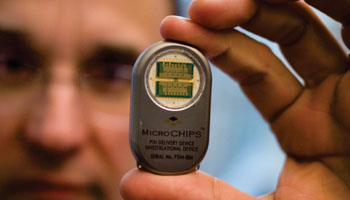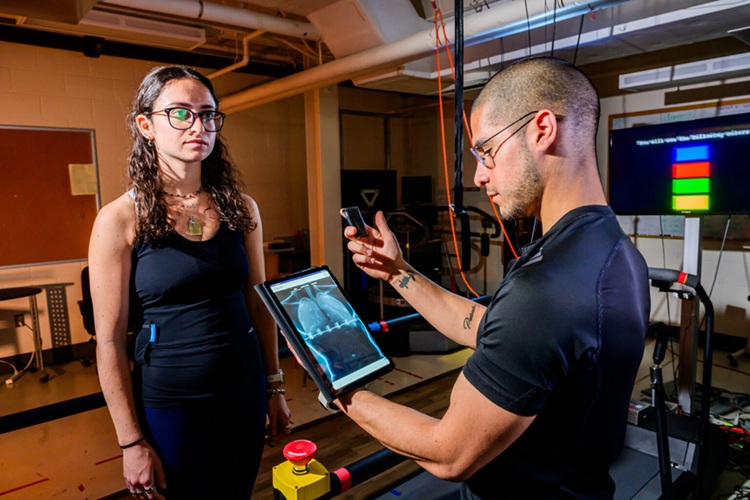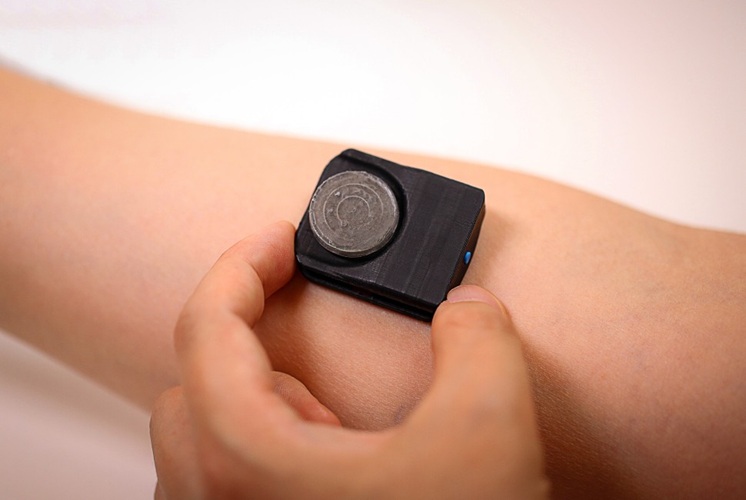Contraceptive Implant Hails New Era of Birth Control
|
By HospiMedica International staff writers Posted on 22 Jul 2014 |

Image: A prototype contraceptive implant (Photo courtesy of MicroCHIPS).
A fingernail-sized implant holds enough 30-microgram daily doses of levonorgestrel to provide contraception for 16 years.
Developed by MicroCHIPS (Lexington, MA, USA), a MIT (Cambridge, MA, USA) startup, the device, which measures just 20 x 20 x 7 millimeters, is designed to be implanted under the skin of the buttocks, upper arm, or abdomen. It then dispenses a daily dose levonorgestrel from a reservoir sealed with a titanium and platinum hermetic stopper. Passing an electric current through the stopper melts it temporarily, allowing a 30-microgram dose of the hormone to diffuse out each day.
Women who receive the implant also get a remote control that allows them to halt or restart the implant on demand; to conceive, women turn off the implant with a remote control; another click of the remote restarts it. Doctors could also adjust dosages remotely. MicroCHIPS have previously demonstrated how the microchip technology could release daily doses of an osteoporosis drug. The new application could revolutionize the level of control women have over their birth control technologies.
The technology also includes a secure encryption protocol to prevent outsiders from blocking or reprogramming the implants wirelessly. Another safety factor is that the device is triggered remotely by radio communication over a special frequency called Medical Implant Communication Service (MICS), which only works over a very short distance, almost requiring skin contact to function. The device will begin preclinical testing in the US in 2015, with the goal of market approval by 2018. The study describing the technology was published on July 4, 2014, in MIT Technology Review.
“The idea of using a thin membrane like an electric fuse was the most challenging and the most creative problem we had to solve,” said Robert Farra, president of MicroCHIPS. “We have heard a lot of positive feedback. Women are excited about the capability to change the state of an implant without having to go through another procedure to have it removed. They like the long-term medication, and not having to remember to take medication each day.”
Related Links:
MicroCHIPS
MIT
Developed by MicroCHIPS (Lexington, MA, USA), a MIT (Cambridge, MA, USA) startup, the device, which measures just 20 x 20 x 7 millimeters, is designed to be implanted under the skin of the buttocks, upper arm, or abdomen. It then dispenses a daily dose levonorgestrel from a reservoir sealed with a titanium and platinum hermetic stopper. Passing an electric current through the stopper melts it temporarily, allowing a 30-microgram dose of the hormone to diffuse out each day.
Women who receive the implant also get a remote control that allows them to halt or restart the implant on demand; to conceive, women turn off the implant with a remote control; another click of the remote restarts it. Doctors could also adjust dosages remotely. MicroCHIPS have previously demonstrated how the microchip technology could release daily doses of an osteoporosis drug. The new application could revolutionize the level of control women have over their birth control technologies.
The technology also includes a secure encryption protocol to prevent outsiders from blocking or reprogramming the implants wirelessly. Another safety factor is that the device is triggered remotely by radio communication over a special frequency called Medical Implant Communication Service (MICS), which only works over a very short distance, almost requiring skin contact to function. The device will begin preclinical testing in the US in 2015, with the goal of market approval by 2018. The study describing the technology was published on July 4, 2014, in MIT Technology Review.
“The idea of using a thin membrane like an electric fuse was the most challenging and the most creative problem we had to solve,” said Robert Farra, president of MicroCHIPS. “We have heard a lot of positive feedback. Women are excited about the capability to change the state of an implant without having to go through another procedure to have it removed. They like the long-term medication, and not having to remember to take medication each day.”
Related Links:
MicroCHIPS
MIT
Latest Patient Care News
- Portable Biosensor Platform to Reduce Hospital-Acquired Infections
- First-Of-Its-Kind Portable Germicidal Light Technology Disinfects High-Touch Clinical Surfaces in Seconds
- Surgical Capacity Optimization Solution Helps Hospitals Boost OR Utilization

- Game-Changing Innovation in Surgical Instrument Sterilization Significantly Improves OR Throughput
- Next Gen ICU Bed to Help Address Complex Critical Care Needs
- Groundbreaking AI-Powered UV-C Disinfection Technology Redefines Infection Control Landscape
- Clean Hospitals Can Reduce Antibiotic Resistance, Save Lives
- Smart Hospital Beds Improve Accuracy of Medical Diagnosis
- New Fast Endoscope Drying System Improves Productivity and Traceability
- World’s First Automated Endoscope Cleaner Fights Antimicrobial Resistance
- Portable High-Capacity Digital Stretcher Scales Provide Precision Weighing for Patients in ER
- Portable Clinical Scale with Remote Indicator Allows for Flexible Patient Weighing Use
- Innovative and Highly Customizable Medical Carts Offer Unlimited Configuration Possibilities
- Biomolecular Wound Healing Film Adheres to Sensitive Tissue and Releases Active Ingredients
- Wearable Health Tech Could Measure Gases Released From Skin to Monitor Metabolic Diseases
- Wearable Cardioverter Defibrillator System Protects Patients at Risk of Sudden Cardiac Arrest
Channels
Critical Care
view channel
Novel Intrabronchial Method Delivers Cell Therapies in Critically Ill Patients on External Lung Support
Until now, administering cell therapies to patients on extracorporeal membrane oxygenation (ECMO)—a life-support system typically used for severe lung failure—has been nearly impossible.... Read more
Generative AI Technology Detects Heart Disease Earlier Than Conventional Methods
Detecting heart dysfunction early using cost-effective and widely accessible tools like electrocardiograms (ECGs) and efficiently directing the right patients for more expensive imaging tests remains a... Read more
Wearable Technology Predicts Cardiovascular Risk by Continuously Monitoring Heart Rate Recovery
The heart's response to physical activity is a vital early indicator of changes in health, particularly in cardiovascular function and mortality. Extensive research has demonstrated a connection between... Read more
Wearable Health Monitoring Device Measures Gases Emitted from and Absorbed by Skin
The skin plays a vital role in protecting our body from external elements. A key component of this protective function is the skin barrier, which consists of tightly woven proteins and fats that help retain... Read moreSurgical Techniques
view channel
Intravascular Imaging for Guiding Stent Implantation Ensures Safer Stenting Procedures
Patients diagnosed with coronary artery disease, which is caused by plaque accumulation within the arteries leading to chest pain, shortness of breath, and potential heart attacks, frequently undergo percutaneous... Read more
World's First AI Surgical Guidance Platform Allows Surgeons to Measure Success in Real-Time
Surgeons have always faced challenges in measuring their progress toward surgical goals during procedures. Traditionally, obtaining measurements required stepping out of the sterile environment to perform... Read moreHealth IT
view channel
Printable Molecule-Selective Nanoparticles Enable Mass Production of Wearable Biosensors
The future of medicine is likely to focus on the personalization of healthcare—understanding exactly what an individual requires and delivering the appropriate combination of nutrients, metabolites, and... Read more
Smartwatches Could Detect Congestive Heart Failure
Diagnosing congestive heart failure (CHF) typically requires expensive and time-consuming imaging techniques like echocardiography, also known as cardiac ultrasound. Previously, detecting CHF by analyzing... Read moreBusiness
view channel
Expanded Collaboration to Transform OR Technology Through AI and Automation
The expansion of an existing collaboration between three leading companies aims to develop artificial intelligence (AI)-driven solutions for smart operating rooms with sophisticated monitoring and automation.... Read more

















